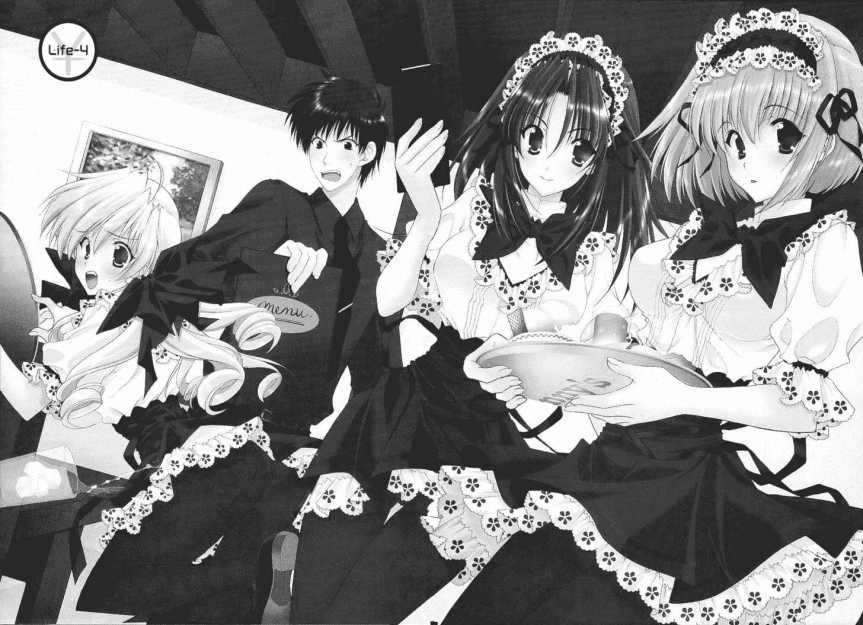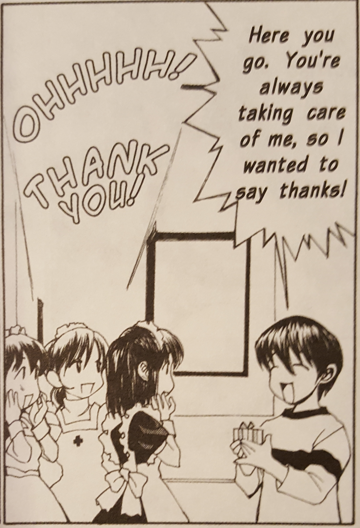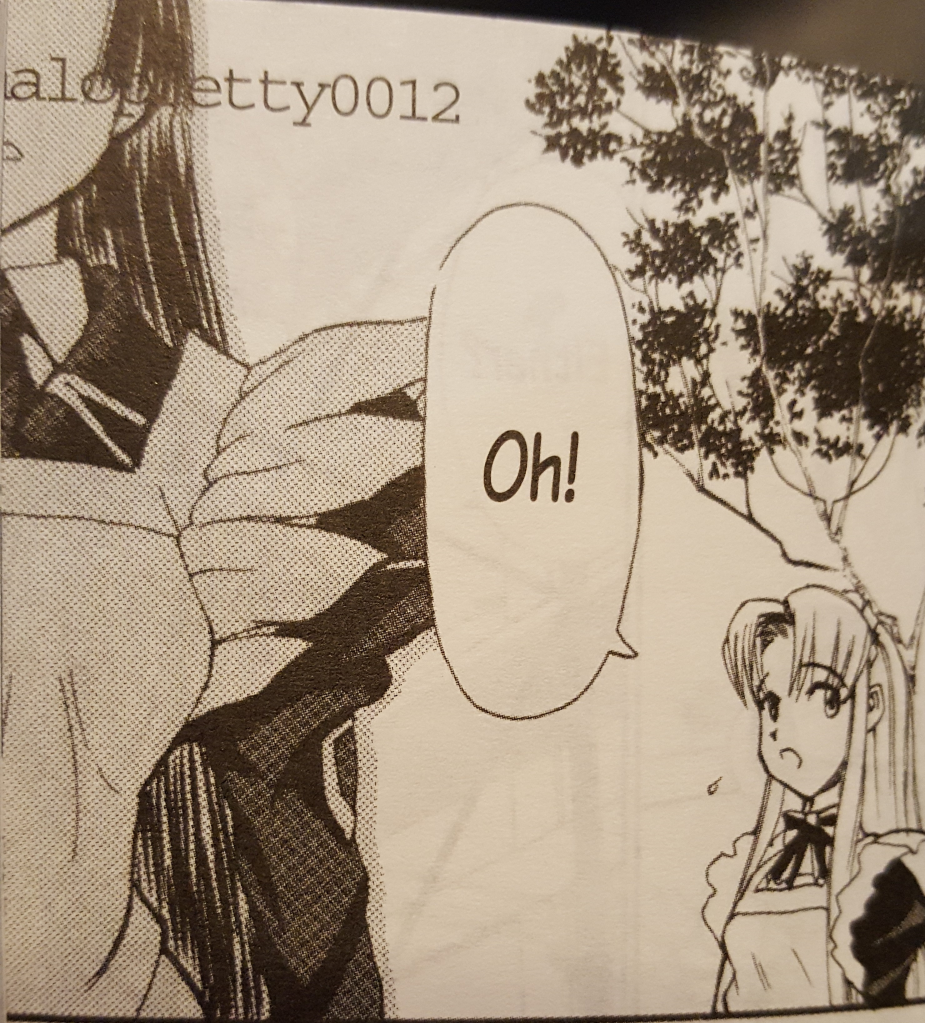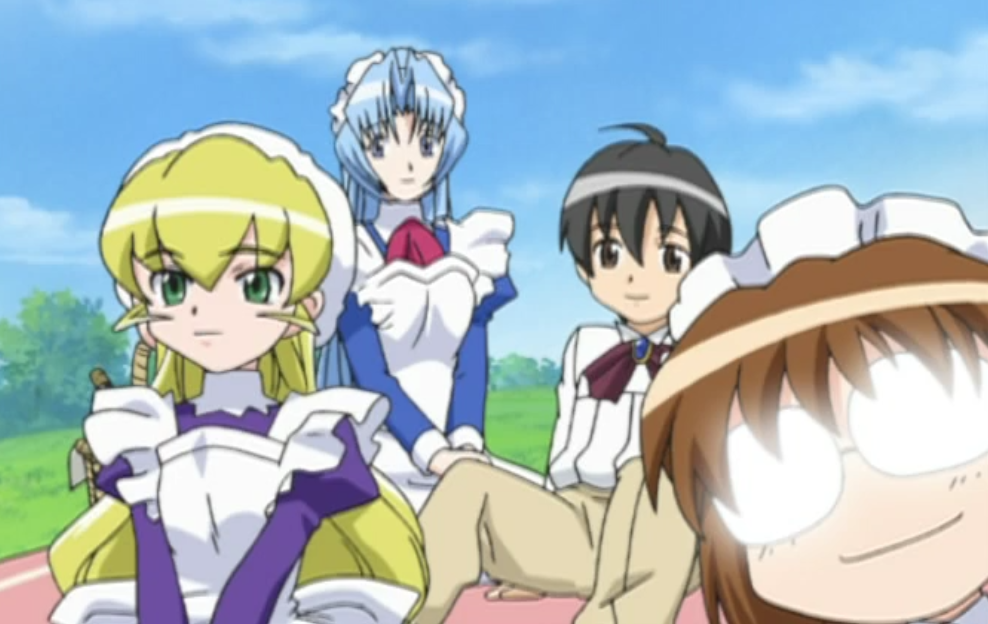They say March comes in like a lamb and goes out like a lion… so what does “Maid May” do? Since we started this month to celebrate anime and manga maids with a long expose on the hilarious and extraordinarily messed-up He Is My Master, it only seems right that we end it on a very different note with a review of the short and sweet manga Saving Life by Mario Kaneda. This manga deserves a spot on a site like Anime Obscura more than most, because neither the manga (which only received a single volume released stateside) nor its author even have their own Wikipedia page at the date of this review. That doesn’t mean they’re not worth checking out, as I quite enjoyed my time with this one.


Saving Life tells the story of Haruhiko Ayanokouji, a teenage boy who was born into a life of fabulous wealth. His family lived in a mansion, had a whole staff of maids and servants, and controlled a huge conglomerate named after them. However, Haruhiko rebels against what he calls his father’s tyranny, which he later specifies involves forcing him to abide by some unnamed “condition,” and he leaves home to make his own way in the world. This means that the rich kid is suddenly living the pauper’s life in a total dump of a house, but to Haruhiko’s credit, he is a capable and hard worker, so he’s gradually making headway in lifting himself out of debt, if not out of poverty.
He’s helped in this effort by his cute and responsible friend Yoriko, who can be a bit of a taskmaster when it comes to scolding him on keeping up with schoolwork. At the same time, she clearly also has a bit of a crush on him. Haruhiko catches a bit of a break when he gets a job at a family restaurant called Danny’s (a transparently clear reference to Denny’s), but his good luck is counterbalanced by the fact that his clumsy blonde senpai, Junko, somehow gets it into her head that his competence is a sign that he’s a spy from a rival restaurant. This beautiful, hyper-competitive, and dumb-as-a-rock girl vows to somehow seal his professional doom.

Finally, at the end of the opening chapter, Haruhiko is shocked upon his arrival home to find his and Yoriko’s childhood friend, Nanako, waiting for him in his house and dressed as a maid. (Aha, aha, you see? There it is!) Although not explained in detail in Volume One, it’s hinted that Nanako was the child of a servant in the Ayanokouji household during her girlhood and has learned to be a professional maid in the years since then. She explains to Haruhiko that his family was worried about him, and so was she, and they gave their blessing on her moving in as his live-in maid despite his rotten financial circumstances. From here, we follow Haruhiko and his girl-friends (not girlfriends, as yet) as our boy tries to live the “saving life” of the title and survive on a budget.

I discovered this manga during a dive in RightStuf’s clearance bin and picked it up for just a few dollars. Trying to dig up more info on this series was and is none too easy. Its back cover advertises that its author (Mario Kaneda) was also responsible for the much more successful Girl’s Bravo, and it was a Tokyopop manga released in 2010. That second fact alone speaks volumes, since that once-massive manga publisher was in the middle of a downward financial spiral that year that would end in its total shutdown and near-dissolution in the early months of 2011. Tons of titles part-way through publication at that time were sucked into the abyss of Tokyopop’s sinking ship at that time, never to be seen again, and I’m sad to say that the planned subsequent volumes of Saving Life suffered the same fate. There is a page for Volume 2 on Amazon with an anticipated release date, but based on the timeline, I’m quite sure it never made it to print. This seems to have been a short series even in its original Japanese run, with one site I found advertising a “complete run” of 3 volumes.
As an incomplete series, is it even possible to recommend Saving Life? Well… it does make it harder to recommend, but as I mentioned in the introduction, I honestly did enjoy this volume. Saving Life has a couple of things going for it that make it a pleasure to read.

The art in this volume is excellent and does a great job of accentuating the comedy, cuteness, or seriousness of the situation, as the scene might require. This is a harem and ecchi comedy, with plenty of “convenient” stumbles, wet T-shirts, and panty flashes, but the flavor of fanservice on display here is much more cute than lewd. Even in some of the more revealing scenes, it’s pulled off respectfully and doesn’t make you think less of the characters involved. The character designs were appealing, and often their facial expressions when they reacted to things were a hilarious highlight. One of the few negatives I’d mention on the artwork is that most of the backgrounds were nondescript and bland compared to the vivid characters interacting inside them.
I also really enjoyed our main cast of characters, all of whom had some really funny personality traits that made for great running gags. The penny-pinching Haruhiko is an absolute skinflint and cheapskate, and his ability to do anything better when he’s getting paid for it was really fun. I thought Yoriko struck a great balance between being super-supportive yet blisteringly independent, and Nanako’s mystical ability to kinda-sorta repair things and her slightly dirty mind beneath a cute exterior were both great. I also thoroughly loved the female friendship on display between Yoriko and Nanako. Harem comedies where the female characters are at each other’s throats in a perpetual cold-war catfight are dime-a-dozen, but the fact that Yoriko and Nanako thoroughly like, trust, and help each other based on their childhood friendship (and in turn, both usually extend that same benefit of a doubt to Haruhiko) was a real breath of fresh air.

The writing is hard to comment on since we only made it a single volume into the series, but it seemed to be setting up a gradual reveal of exactly what Haruhiko’s father did or asked him to do that caused the familial rupture. We also see the beginnings of an anime/manga harem forming, with Yoriko, Nanako, and even Junko all coming to like Haruhiko a little bit, but there are enough differences in their relationships that one can imagine several of these resolving in close friendships rather than a romantic relationship. The style of the writing is episodic and lighthearted – the author obviously wasn’t trying to write a romance for the ages, but a cute and funny comedy with romantic and mystery elements thrown in, and it was shaping up to be a fun little ride I wish had made it a bit farther.

As the concluding entry in “Maid May” of 2021, I do have to mention that the “maid” element in this book is weaker than in many of the other titles I’ve featured this month. The fact that Nanako is a maid isn’t well-explained, and neither she nor any of the other characters make a very big deal out of it. The “maid thing” is present in various ways, though. Nanako dresses like a maid in Haruhiko’s home, she has obviously worked as a maid at some point, we see some maids in his family’s home, and the “Danny’s” restaurant uniforms for female employees have some maid-like touches in their frilliness. Moreover, the defining trait of the anime maid subgenre – a funny story about clumsy but cute girls attempting to take care of a clueless dude – is on full display here. Saving Life won’t rock your world, but you might be able to say it maid your day if you give it a chance.
If you want to get this manga volume as a cart-topper from RightStuf, they still have volumes in stock at the time of this review, and you could certainly do worse in your forays into their clearance section. It can also be picked up on the used market on eBay for a reasonable price as well.
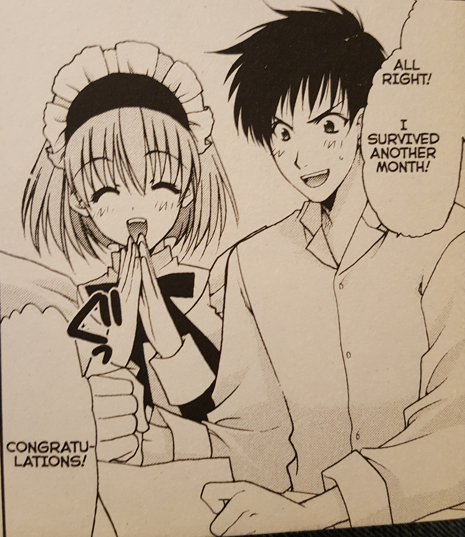
Thank you for sticking with me this month as we took our time in exploring one of Japan’s stranger cross-cultural obsessions, and hopefully you discovered (as I did) a great series or two to enjoy as we head into the hot summer months. Take care, and May the maid uniform be with you!


